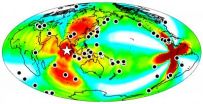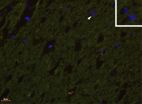(Press-News.org) SANTA CRUZ, CA--The massive earthquake that struck under the Indian Ocean southwest of Sumatra on April 11, 2012, came as a surprise to seismologists and left them scrambling to figure out exactly what had happened. Analysis of the seismic waves generated during the event has now revealed a complicated faulting process unlike anything seen before.
"Nobody was anticipating an earthquake of this size and type, and the complexity of the faulting surprised everybody I've spoken to about this," said Thorne Lay, professor of Earth and planetary sciences at the University of California, Santa Cruz.
Lay, UCSC graduate student Han Yue, and University of Utah geologist Keith Koper have published a detailed analysis of the fault ruptures in Nature (published online September 26). Another team reported a similar pattern of faults in a recent paper in Science, but without the quantitative details provided in the new paper, which is accompanied by two other papers addressing different aspects of this unusual earthquake.
During the magnitude 8.7 earthquake, the Indo-Australian plate--a major tectonic plate that includes Australia and the surrounding ocean--ruptured over a complex network of at least four faults lying at right angles to one another. According to Lay, the energy released on each fault individually was about magnitude 8, adding up to a total event magnitude of 8.7 (a point higher than the 8.6 value initially reported for the quake). The initial shock was followed two hours later by a magnitude 8.2 aftershock on yet another fault to the south.
Most great earthquakes (magnitude 8 and above) occur at the edges of plates in subduction zones, where one plate is diving under the adjoining plate and motion along the fault causes vertical displacement of the surface. The April earthquake involved horizontal ("strike-slip") motion on a series of faults in the middle of the plate. It was both the largest strike-slip earthquake and the largest intraplate earthquake ever recorded. The faults broke through the upper part of the plate and appear to have slipped as much as 35 to 40 meters during the quake, Lay said.
"What we're seeing here is the Indo-Australian plate fragmenting into two separate plates," he said. "We've seen local fragmentation on a small scale, but this is an unprecedented opportunity for us to witness it on the scale of a giant tectonic plate."
The fragmentation is caused by stresses within the plate resulting from its collision with Asia in the northwest, which slows down the western part of the plate, while the other side continues moving steadily north, sliding under Sumatra to the northeast. The Indian subplate will eventually separate from the Australian subplate, but exactly where the plate boundary will form is not yet clear, Lay said.
He added that the process of forming a new plate boundary will take millions of years and is likely to require hundreds if not thousands of earthquakes like the one in April. "This was a huge earthquake, but it's going to happen again and again to make a through-going fracture that separates the plates," he said.
The good news is that this is not a particularly hazardous type of earthquake, because the horizontal slip does not displace the water above the fault enough to generate a big tsunami. "It doesn't present a lot of societal hazard, so that's good," Lay said. "It is humbling, though, that this event was well beyond anything we could anticipate."
### This research was funded by the National Science Foundation.
Study reveals complex rupture process in surprising 2012 Sumatra quake
April event was the largest earthquake ever recorded in the middle of a tectonic plate and involved an unprecedented series of fault ruptures
2012-09-27
ELSE PRESS RELEASES FROM THIS DATE:
Men on the mind: Study finds male DNA in women's brains
2012-09-27
SEATTLE – Male DNA is commonly found in the brains of women, most likely derived from prior pregnancy with a male fetus, according to first-of-its-kind research conducted at Fred Hutchinson Cancer Research Center. While the medical implications of male DNA and male cells in the brain are unknown, studies of other kinds of microchimerism – the harboring of genetic material and cells that were exchanged between fetus and mother during pregnancy – have linked the phenomenon to autoimmune diseases and cancer, sometimes for better and other times for worse.
The study findings ...
Pregnancy generates maternal immune-suppressive cells that protect the fetus
2012-09-27
A new study published online in the journal Nature suggests it might be possible to develop vaccines to prevent premature birth and other pregnancy complications. If so, such vaccines would be the first intended to stimulate the subset of regulatory CD4 T cells that suppress the immune response.
Current vaccines are specifically designed to stimulate T cell subsets that activate the immune response.
The study, led by a researcher at Cincinnati Children's Hospital Medical Center, shows the immune system of a pregnant mother stimulates cells that selectively prevent ...
Researchers define 2 categories of multiple sclerosis patients
2012-09-27
BOSTON, MA—There are approximately 400,000 people in the United States with multiple sclerosis. Worldwide, the number jumps to more than 2.1 million people. Rather than a one-size-fits-all approach to treating the millions with multiple sclerosis, what if doctors could categorize patients to create more personalized treatments? A new study by researchers at Brigham and Women's Hospital (BWH) may one day make this idea a reality in the fight against the debilitating autoimmune disease.
A research team led by Philip De Jager, MD, PhD, BWH Department of Neurology, senior ...
Touch-sensitive tentacles catapult prey into carnivorous plant traps
2012-09-27
Swift predators are common in the animal world but are rare in the plant kingdom. New research shows that Drosera glanduligera, a small sundew from southern Australia, deploys one of the fastest and most spectacular trapping mechanisms known among carnivorous plants.
The study, published Sep. 26 in the open access journal PLOS ONE, is a collaboration between the Plant Biomechanics Group at the University of Freiburg and private sundew cultivators from Weil am Rhein, and provides the first experimental demonstration of fast-moving snap tentacles in sundew plants propelling ...
Large 2012 earthquake triggered temblors worldwide for nearly a week
2012-09-27
This year's largest earthquake, a magnitude 8.6 temblor on April 11 centered in the East Indian Ocean off Sumatra, did little damage, but it triggered quakes around the world for at least a week, according to a new analysis by seismologists from the University of California, Berkeley, and the U.S. Geological Survey (USGS).
The April 11 quake was unusually large – the tenth largest in the last 100 years and, similar to a few other recent large quakes, triggered small quakes during the three hours it took for seismic waves to travel through Earth's crust.
The new study ...
Cannabis withdrawal symptoms might have clinical importance
2012-09-27
Cannabis users have a greater chance of relapse to cannabis use when they experience certain withdrawal symptoms, according to research published Sep. 26 in the open access journal PLOS ONE led by David Allsop of the National Cannabis Prevention and Information Centre (NCPIC) at the University of New South Wales.
The authors tested a group of dependent cannabis users over a two week period of abstinence for impairment related to their withdrawal symptoms. Findings were correlated with the probability of relapse to cannabis use during the abstinence period, and the level ...
First evidence of fetal DNA persisting in human brain tissue
2012-09-27
Small portions of male DNA, most likely left over in a mother's body by a male fetus can be detected in the maternal brain relatively frequently, according to a report published Sep. 26 in the open access journal PLOS ONE by William Chan of Fred Hutchinson Cancer Research Center and his colleagues.
The process, called fetal 'microchimerism (Mc)', is common in other tissues such as blood, but this is the first evidence of male Mc in the human female brain. Microchimerism can be both beneficial and harmful to maternal health, since it is associated with processes such ...
Viewing gender-specific objects influences perception of gender identity
2012-09-27
Spending too much time looking at high heels may influence how a viewer perceives the gender of an androgynous face, according to new research published Sep. 26 in the open access journal PLOS ONE by Amir Homayoun Javadi of Technische Universität, Dresden and his colleagues. The study sheds new light on how the objects surrounding us may influence our perceptions of gender.
The authors found that when people view objects highly associated with one gender, like high heels for women or electric shavers for men, for a short period of time and are then asked to identify the ...
Psychology of equine performance and the biology behind laminitis
2012-09-27
Achieving the best performance from a horse is the goal of not just professional riders, but also the millions of amateur and hobby riders all over the world. A new article published in BioMed Central's open access journal BMC Veterinary Research looks at the issues surrounding training, competition environment and practices, and how the psychology of horse mood, emotion and temperament can be used to enhance performance. A sister article looks at the devastating disease laminitis, and finds that the anti-inflammatory protein apolipoprotein A-IV (APOA-IV) is raised in chronic ...
Scientists make old muscles young again in attempt to combat aging
2012-09-27
An international team of scientists have identified for the first time a key factor responsible for declining muscle repair during ageing, and discovered how to halt the process in mice with a common drug. Although an early study, the findings provide clues as to how muscles lose mass with age, which can result in weakness that affects mobility and may cause falls.
The study, to be published in the journal Nature, involved researchers from King's College London, Harvard University and Massachusetts General Hospital.
The study looked at stem cells found inside muscle ...
LAST 30 PRESS RELEASES:
Exploring how the visual system recovers following injury
Support for parents with infants at pediatric check-ups leads to better reading and math skills in elementary school
Kids’ behavioral health is a growing share of family health costs
Day & night: Cancer disrupts the brain’s natural rhythm
COVID-19 vaccination significantly reduces risk to pregnant women and baby
The role of vaccination in maternal and perinatal outcomes associated with COVID-19 in pregnancy
Mayo Clinic smartwatch system helps parents shorten and defuse children's severe tantrums early
Behavioral health spending spikes to 40% of all children’s health expenditures, nearly doubling in a decade
Digital cognitive behavioral treatment for generalized anxiety disorder
Expenditures for pediatric behavioral health care over time and estimated family financial burden
Air conditioning in nursing homes and mortality during extreme heat
The Alps to lose a record number of glaciers in the next decade
What makes a good proton conductor?
New science reporting guide published for journalists in Bulgaria
New international study reveals major survival gaps among children with cancer
New science reporting guide published for journalists in Turkey
Scientists develop a smarter mRNA therapy that knows which cells to target
Neuroanatomy-informed brain–machine hybrid intelligence for robust acoustic target detection
Eight SwRI hydrogen projects funded by ENERGYWERX
The Lundquist Institute and its start-up company Vitalex Biosciences Announces Strategic Advancement of Second-Generation fungal Vaccine VXV-01 through Phase 1 Trials under $40 Million Competitive Con
Fine particles in pollution are associated with early signs of autoimmune disease
Review article | Towards a Global Ground-Based Earth Observatory (GGBEO): Leveraging existing systems and networks
Penn and UMich create world’s smallest programmable, autonomous robots
Cleveland researchers launch first major study to address ‘hidden performance killer’ in athletes
To connect across politics, try saying what you oppose
Modulating key interaction prevents virus from entering cells
Project explores barriers to NHS career progression facing international medical graduates
Jeonbuk National University researchers explore the impact of different seasonings on the flavor perception of Doenjang soup
Two Keck Medicine of USC Hospitals named Leapfrog Top Teaching Hospitals
World-first discovery uncovers how glioblastoma tumours dodge chemotherapy, potentially opening the door to new treatments
[Press-News.org] Study reveals complex rupture process in surprising 2012 Sumatra quakeApril event was the largest earthquake ever recorded in the middle of a tectonic plate and involved an unprecedented series of fault ruptures





